
Line-out
Encyclopedia
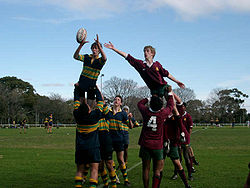
Rugby union
Rugby union, often simply referred to as rugby, is a full contact team sport which originated in England in the early 19th century. One of the two codes of rugby football, it is based on running with the ball in hand...
, the ball is put back into play after it has gone into touch
Touch (rugby)
Touch is the area outside two touch-lines which define the sides of the playing area in a game of rugby football. As the touch-lines are not part of the playing area they are usually included as part of touch....
. It is the equivalent of the throw-in
Throw-in
A throw-in is a method of restarting play in a game of Association football.-Procedure:The throw-in is taken from the point where the ball crossed the touch-line. The throw-in is taken by the opponents of the player who last touched the ball when it crossed the touch-line, either on the ground or...
in soccer. Rugby league
Rugby league
Rugby league football, usually called rugby league, is a full contact sport played by two teams of thirteen players on a rectangular grass field. One of the two codes of rugby football, it originated in England in 1895 by a split from Rugby Football Union over paying players...
abolished line-outs in 1897. Instead, a scrum
Scrum (rugby)
Scrum , in the sports of rugby union and rugby league, is a way of restarting the game, either after an accidental infringement or when the ball has gone out of play...
takes place 20 metres infield from the spot where the ball went out and where a line-out would take place in rugby union.
When a player puts the ball into touch (that is, out of the field of play), the opposing team is awarded a line-out. An exception is that if the ball is kicked into touch from a penalty kick
Penalty (rugby union)
A penalty in rugby union is the main disciplinary sanction available to the referee to penalise a team who commit deliberate infringements. The team who did not commit the infringement are given possession of the ball and they may either kick it towards touch , attempt a place kick at goal, or tap...
, the team that was awarded the penalty throws in to the resulting line-out.
Where the line-out is taken depends on the manner in which the ball was played into touch. If it is kicked directly into touch, without first landing in the field-of-play or touching the referee or an opponent who is not in touch, the line-out is formed in line with the spot from where it was kicked, with two exceptions: if the kick was a penalty kick or if the kicker had at least one foot on or behind his own 22-metre line, the line-out is formed at the spot where the ball crossed the touch-line. In all other cases, the line-out is formed at the spot where the ball crossed the touch-line, except that if this spot is within 5 metres of the goal-line, the line-out is formed on the 5-metre line. A line-out is also awarded if a player in possession of the ball crosses or touches the touchline whilst still in possession of the ball.
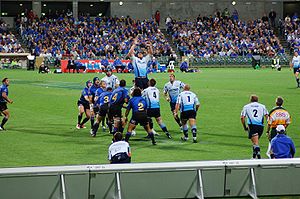
Formation
A line-out is formed with a minimum of two players from each side; the maximum number is determined by the team throwing in and their opponents must not have more players in the line-out (though they can have fewer). The players forming the line-out must stand at least 5 metres, but not more than 15 metres, from the touch-line, in two parallel lines, each team's players standing at least half a metre on their side of the "line of touch" (an imaginary line extending the full width of the pitch, at right angles to the touch-line at the point where the line-out is formed), so that there is a gap of at least one metre between the opposing lines.A player from the throwing team, usually (but not always) the hooker, throws the ball in. He stands with both feet outside the field-of-play and must throw the ball straight, along the gap between the teams, without feinting or dummying the throw. The thrower may throw the ball as high and as far as he wishes and players forming part of the line-out are allowed to jump up and catch the ball. Players who do not themselves jump for the ball may support a jumper from their team, but are not allowed to lift the jumper or otherwise support him before he has left the ground, provisions that are rarely enforced in practice.
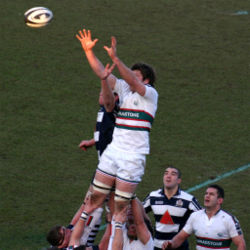
Players not forming part of the line-out, or acting as receiver, must stay at least ten metres from the line of touch until the line-out is over, except that if the line-out is formed within 10 metres of their goal-line, they need only retreat behind the goal-line. A line-out ends when the ball, or a player carrying it, leaves the line-out, or, if a ruck or maul is formed at the line-out, when all the feet of all the players forming the ruck or maul move beyond the line of touch.
The lineout was originally contested with both teams jumping unsupported to retrieve the ball. However, lifting in the lineout was later introduced and under Law 19 of the IRB rules, players are now allowed to pre-grip and lift their teammates in the lineout. It is thought that lifting in the lineout was first introduced by a Trafford MV RFCC player named Bernard Millington in the early 1980s.
Codes
Teams usually employ a line-out codeLine-out code
A line-out code is a coded piece of information, used to communicate intentions about a line-out within one team in a rugby union match without giving information away to the other team. A line-out is a manoeuvre used to restart play when the ball has left the pitch...
, to ensure that all players on that team know what is planned, who the ball will be thrown to, what that player will do with it, and what follow-up ploy is intended. One player from the throwing team is usually designated to shout the code, and it is particularly important that the thrower should know what the code is, so that he can execute the throw as intended.
Rules
Players must not interfere with the opposition during the line-out. In particular, they must not interfere with or tackle a jumper while his feet are off the ground, or interfere with players supporting him; such actions are deemed to be dangerous play and will be penalised with a penalty kick. Players in the line-out must not close the gap or enter the gap, except in the act of jumping for the ball, nor may they jump or support a jumper before the ball is thrown; such actions are penalised with a free-kick. Penalty kicks and free kicks are awarded 15 metres infield from the touch-line.If the ball is thrown beyond the 15-metre line, a player from the throwing team who is not taking part in the line-out may run forward to take the ball. If he does so, an opponent may also run forward to contest possession. Players who are taking part in the line-out may move beyond the 15-metre line as soon as the ball leaves the thrower's hands. If, however, a player runs forward or infield and the ball is not thrown beyond the 15-metre line, that player is off-side. The line-out ends when the ball crosses the 15-metre line.
Players from the side not throwing may jump to compete for the ball, though they must be careful not to attract a penalty for interfering with an opposing jumper. Alternatively, they may choose not to contest the line-out but to drive onto the catcher as soon as he returns to the ground. Often, when a team is awarded a line-out close to their opponent's goal-line, they will attempt to form a maul around the catcher and drive over the goal-line to score a try. In such cases, the defending team will often seek to disrupt this tactic by driving in on the catcher, taking him to ground immediately, before a maul can form.
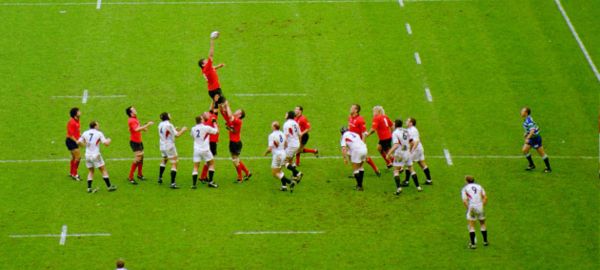
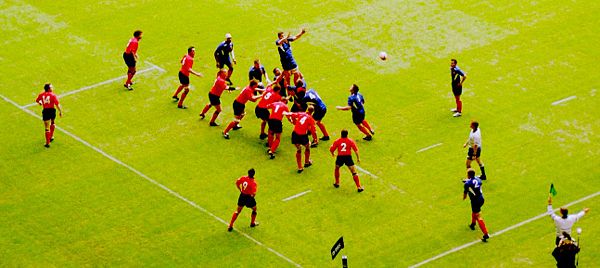
International Rugby Board
The International Rugby Board is the governing body for the sport of rugby union. It was founded in 1886 as the International Rugby Football Board by the unions of Scotland, Wales and Ireland. England refused to join until 1890. The International Rugby Football Board changed its name to the...
is currently evaluating a number of "experimental law variations
Experimental law variations
The experimental law variations were a proposed set of amendments to the laws of rugby union. They were propsed by the sport's governing body, the International Rugby Board , and trialled games at Stellenbosch University in 2006...
" (ELVs, also known as the Stellenbosch Laws because they were first employed at the University of Stellenbosch, in South Africa
South Africa
The Republic of South Africa is a country in southern Africa. Located at the southern tip of Africa, it is divided into nine provinces, with of coastline on the Atlantic and Indian oceans...
). The proposals have important implications for the line-out:
- The throwing team would no longer determine the number of players in the line-out. Each team would be able to have as many players as it chose in the line-out, the only restriction being that the line must still be formed between the 5- and 15-metre lines.
- The opposing hooker would no longer be required to stand within 5 metres of the touch-line, provided that wherever he chose to stand conformed to the laws.
As part of the IRB's continuing process of evaluating the proposed changes, SANZAR
SANZAR
SANZAR is the body which operates Super Rugby and Tri Nations competitions in rugby union. It is a joint venture of the South African Rugby Union, the New Zealand Rugby Union and the Australian Rugby Union, formed in 1996.Created shortly after rugby's move to professionalism in 1995, SANZAR's two...
agreed to implement some of the ELVs during the 2008 Super 14 and Tri Nations series, but among the changes that they decided not to implement were those affecting numbers at the line-out.

